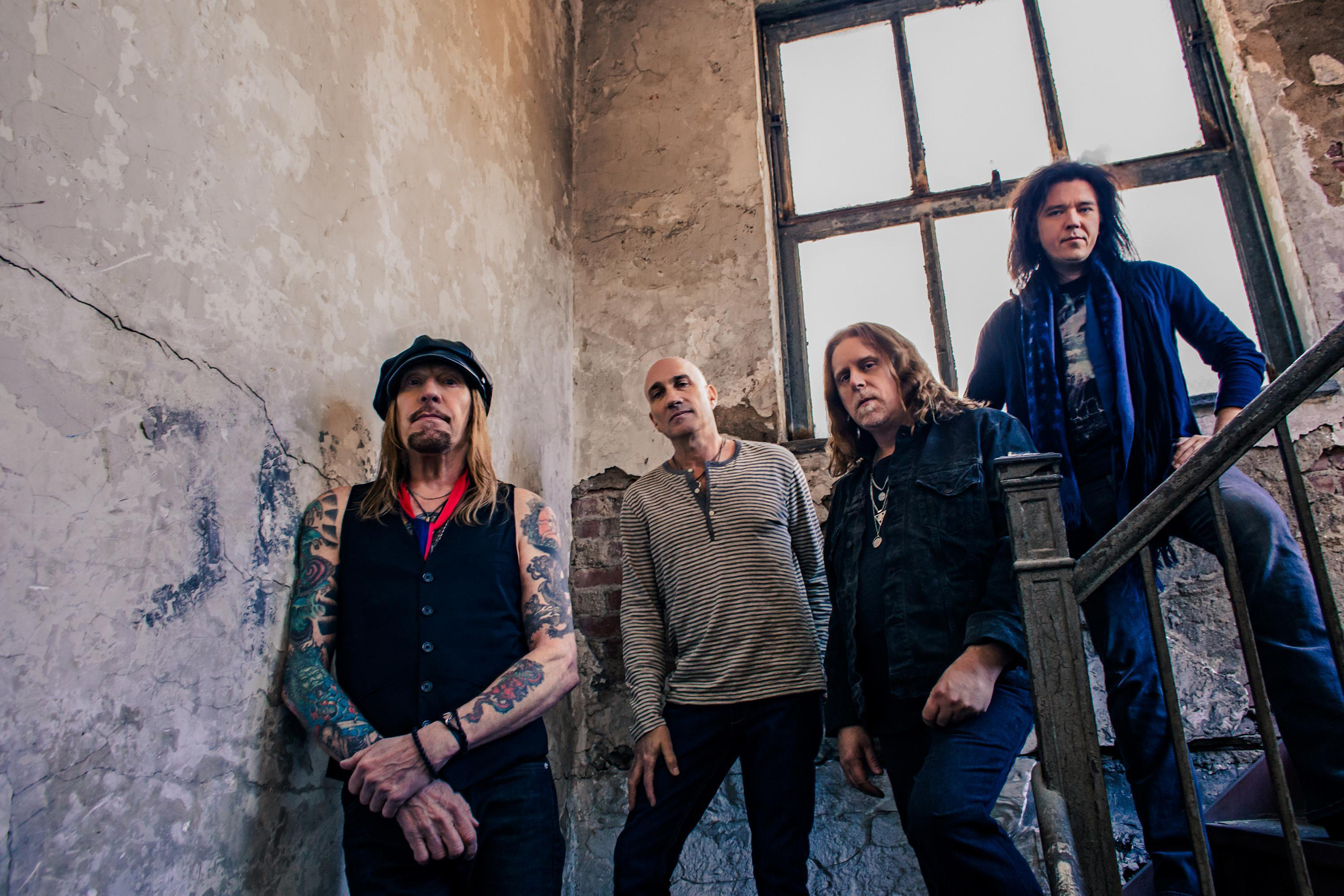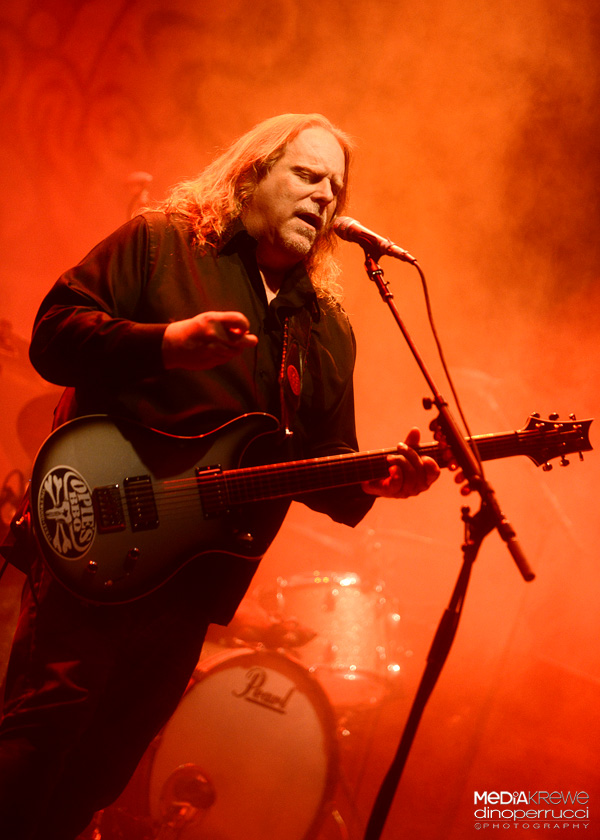Gov’t Mule’s Side Ways

Few contemporary bands can pull off spectacles and special shows as well as Gov’t Mule. Warren Haynes and company harness the chaos of guests and one-off setlists, and turn that into musical magic.
Since 2007, the Mule has embraced this side of itself every Halloween and New Year’s Eve by plunging deeply into the music of a selected artist or genre. The band’s ambitious goal has been to create music that’s not only good enough to satisfy a packed holiday crowd, but also stands the test of time–a fact underlined by a series of archival albums.
The vault releases started with last November’s limited edition, vinyl-only Stoned Side of the Mule, Volume 1 (where they cover The Rolling Stones) and continued with Dark Side of the Mule (their take on Pink Floyd). Dub Side of the Mule, a collection of reggae songs with singer Toots Hibbert, will follow in March. Another collaboration, Sco-Mule—featuring highlights from two 1999 shows where guitarist John Scofield and keyboardist Dr. Dan Matrazzo joined the original trio of Haynes, drummer Matt Abts and bassist Allen Woody—is set for release on January 27. Though Haynes and Scofield have played together frequently in the ensuing years, these Atlanta shows marked the first time the guitarists shared the stage.
“Listening back to them, it strikes me that [Scofield] tended to lean a little more rock than normal and I tended to lean a little more jazz than normal—just being drawn toward each other in a natural way that created some really cool dynamics,” Haynes reflects. “Those shows with John were really the beginning of a transitional period for the Mule. We were starting to open our minds to having more and more special guests play a bigger and bigger part of the overall picture.”
Gov’t Mule will celebrate the long-awaited release of Sco-Mule by touring with Scofield in February and March. “The sky’s the limit for those shows; we can perform endless concepts,” says Haynes. “We can take it in a lot of directions other than what we did on the Sco-Mule shows.”
Haynes says it isn’t a coincidence that Gov’t Mule began releasing these archival one-off shows as they celebrated their 20th anniversary throughout 2014.
“These albums aren’t really recommended starting points to discover Gov’t Mule,” he says. “But this far down the line, people have many choices on how they can discover the band for the first time—and I strongly recommend all of these releases to anyone who already knows the band and wants to get deeper. For us, it’s just the obvious concept of utilizing all of our influences and not wanting to get stereotyped into people thinking they know what we are and not wanting to redo what we’ve already done.”
Taken as a whole, the musical styles and artists that Gov’t Mule have paid tribute to over the years highlight the band’s wide-ranging tastes and influences: Neil Young; Albert, B.B. and Freddie King; AC/DC; Jimi Hendrix; Led Zeppelin; Otis Redding; Toots & The Maytals; Pink Floyd; The Doors; The Rolling Stones; Joe Cocker.
“These shows are a way of us showing appreciation to the artists who influenced us,” says keyboardist and multi-instrumentalist Danny Louis. “They are also a gift to our fans. To me, they represent fulfillment, growth and sharing. We get to put on this big thing and share it with everybody. The fulfillment and growth come from the hard work you have to do to prepare—and I think that any time you work really hard on something, there are benefits to be reaped, both short and long term.
“These shows are like Buddhist sand mandalas,” Louis continues. “Buddhist monks sweat and labor over this beautiful thing, and everyone can look and admire the grace—and then they dump them into the ocean. We work incredibly hard to nail a vast amount of material and then it’s gone.”
Haynes adds, “These projects get very intense. When we undertake the whole process, we’re learning a ton of material and rehearsing it in a limited window of time and that brings a certain urgency and intensity.”
Both Haynes and Louis agree that the shows’ impact extends well beyond the performances themselves. The process sparks creative fervor and collaborative zeal. The group takes on a new level of intensity and focus, and they are forced out of their comfort zone and into learning new material, new approaches—even new instruments. This process applies to each individual and to the band as a whole, but is particularly true for Louis.
As a multi-instrumentalist, he is often tasked with filling in whatever musical holes exist. He studied Leon Russell’s piano style for the Mad Mules & Englishmen Joe Cocker revue, delved into synths and programming for the Pink Floyd set, and honed his guitar chops when the band paid tribute to Jimi Hendrix.
“These shows are always incredibly educational and totally impact what I do,” he says. “It’s like attending a two-week high-intensity seminar and you come out [on] the other side with a new knowledge, as well as the experience that you’ve just gone through, and that can’t help but impact everything else you play. And it’s not just about whatever specific things I learn. If you learn something new and bring it to the workplace and everyone else is doing the same thing, it certainly makes for a better workplace—and that’s just as true in a band as it is anywhere else.”
The Pink Floyd performance was particularly memorable for Louis because the expanded band included his wife, singer Machan Taylor, who also performed on Pink Floyd’s Momentary Lapse of Reason tour. “She got to reprise her ‘Great Gig in the Sky,’” he says. “And it was fantastic to do it together.”
Remarkably, given the Mule’s deep dive into Floyd during the Oct. 31, 2008 show, the performance was only bassist Jorgen Carlsson’s second night with the band. (He debuted the evening before in Burlington, Vt.) The group had rehearsed for about a week, which Haynes says is the most practice time that they have ever had. Gov’t Mule plays a completely different setlist each night, and Carlsson had never publicly played a single song that the group performed before those initial shows.
“It was baptism by fire and he did great,” Haynes says. “He was obviously not as relaxed as he would be a few years later, but there’s a different type of power and intensity. He was locked onto Matt and holding on for dear life, and that gave the shows an extra edge.”
Both Haynes and Louis note that the real challenge in these shows lies in crafting a performance that not only thrills the audience, but also stands the test of time. They are not looking to just jam out the songs or noodle around.
“Basically, we want the show to be as good as any Mule show,” says Louis. “We’ve been playing the heart of our repertoire for upward of a decade, and we’re very familiar with that music and can jam on it and breathe all kinds of life into it. We want to be able to bring the same quality to the music we cover, and you can’t do that by just karaoke-ing it. That would be paint by numbers and it’s not enough. You have to give it the same level of energy, interpretation and experimentation that you bring to your own music.”
The Halloween and New Year’s Eve shows always feature at least one set of Mule music in addition to the artists they choose to cover. Somewhat surprisingly, the original music played does not seem to be influenced by the artists being covered. Haynes says this is done intentionally. “We usually want to offer a contrast and go in a completely different direction. For instance, when we did the Sco-Mule thing, it was the first time we ever played a full set of instrumental music, and the setlist prior to John Scofield taking the stage was consummate Mule because we wanted there to be huge contrast.”
As a result of that, Haynes adds, the Mule sets before each of the special shows tend to be quite distinct and different from one another. “There are very few repeats of original material in the Mule sets of these releases,” he says. “You’re going to get a very wide range of Gov’t Mule here.”

The full range of Gov’t Mule’s influences and their ability to convincingly shapeshift became particularly apparent following Allen Woody’s death in 2000. After a period of uncertainty, Haynes and Abts decided to push forward with the band, beginning with what became the two The Deep End albums, with a host of guest bassists, ranging from Phil Lesh to Flea, and Mike Gordon to Deep Purple’s Roger Glover.
“Playing with all those bass players definitely influenced the future direction of the band,” says Haynes. “It influenced the way I was writing songs, since I was purposely choosing material to play with the guest bass players’ personalities, and then going out and performing those songs live gave us new avenues and influences to explore, and all of that in a way led to these Halloween and New Year’s shows.
“All the guest appearances through the years, plus all The Deep End bass players, would each light some kind of spark that would eventually influence the future direction of the band,” Haynes continues. “That’s also happened with my association with the Allman Brothers, The Dead, Phil and Friends, the Warren Haynes Band and every other artist I’ve been lucky enough to work with. I feel like every- thing we’ve done collectively has led up to where we are now. It’s all in there.”
Since Carlsson replaced Andy Hess in 2008, the Mule has con- tinued to evolve and explicitly takes on more influences. At the same time, they have returned closer to their roots. Carlsson plays the material from the band’s first three albums with a power and drive reminiscent of Woody, certainly much more so than Hess or any of Gov’t Mule’s guest bassists.
“I think a lot of the music we’re doing now is very similar to the music we were making in the earliest years, other than the fact that we’re no longer a trio,” says Haynes.
Haynes says that it would be wrong to assume that the band’s current sound would be wildly different if Woody had survived. His late friend and musical partner remains very much in his thoughts, and Haynes often ponders how the bassist would feel about virtually every creative decision that Gov’t Mule makes.
“Woody was a very opinionated sort, but he also listened to and loved a lot more genres of music than some people would expect,” says Haynes. “He loved folk and bluegrass and played a lot of acoustic instruments and was looking forward to recording them a lot more in Gov’t Mule. He really loved instru- mental music and jazz, which we listened to all the time. He loved Frank Zappa. And as much as he loved the heavier stuff, he was the reason we started playing [Al Green’s] ‘I’m A Ram.’”
Haynes says that he and Woody had a long-term growth plan in mind for Gov’t Mule even before the group’s self-titled 1995 debut. The Mule was a concept long before it was a band, hatched mostly during late-night discussions on cross-country rides on the Allman Brothers tour bus.

“Woody and I often talked about the concepts for the first, second and third records,” he says. “We were very much in agreement that the first record should be live in the studio—a snapshot of Gov’t Mule as an experimental, improvisational rock trio. On the second studio record [Dose, 1998], we were in agreement that it should have a little more production—a few more overdubs, a handful of background vocals, second guitars, acoustic instruments—but it should remain largely similar to the first record.”
Woody often looked to Led Zeppelin for inspiration, noting the growth and changes from Led Zeppelin I and II to III, noticeably an increased use of acoustic instrumentation as well as more melodic songs.
“Woody would talk about how those changes opened the door for Led Zeppelin to paint a wider picture and felt we should have a similar outlook,” Haynes recalls. “By the time we got to the third studio record [Life Before Insanity, 2000], we wanted to be using different instrumentation and writing different types of songs. Woody loved to play guitar and mandolin and all these other string instruments and was always looking for an excuse to play more than just bass, and that factored into the song selection. He brought in this crazy Brazilian instrument [on Dose] for ‘John The Revelator,’ for instance. I was also writing a lot of songs that didn’t sound as good as a trio, and that’s the reason we brought Johnny Neel to play keyboards on half of Life Before Insanity.
“We were facing down the issue that every trio faces,” he continues. “How do you not get bogged down in the bass-guitar- drums-vocals format? That’s where his head was. He was thinking, ‘We’re now making our third record, so let’s make it completely different and open the door to wherever we want to go in the future.’ And in a lot of ways, we did end up following that path.”
Though it has always seemed to most Mule fans that there was a very clear split in eras—pre-Woody and post-Woody—Haynes presents a compelling argument that the group’s ongoing evolution has actually been unfolding since the beginning. In fact, his counterargument is that their current destination wouldn’t be that different if Woody was still alive.
“If you go from Point A to Point F, it might seem like quite a stretch,” says Haynes. “But if you’ve been following all along, and you look at Points B, C, D, E in between, it all makes sense. We’ve come full circle in a lot of ways.”
Ultimately, what might have been doesn’t really matter—what actually was and is matters very much. These archival releases of special shows over the years highlight different sides of the Mule and help paint a compelling picture of a band with a restless creativity that’s always looking around the corner for some new musical niche to explore.
“We have a job to do,” says Danny Louis. “And that’s being the best Gov’t Mule we can be.”



















